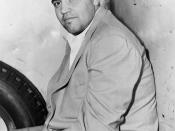The Insanity Defense Part I
Outline
When is the insanity plea a reasonable and ethical tool?
Thesis: Although some criminals abuse the insanity plea by invoking it to escape being punished for their crimes, the insanity plea should nevertheless still be allowed for those with a documented record of mental illness.
I. Background information on the insanity plea [the M'Naughten case]
II. Abusing the insanity plea
III. Importance of the insanity plea in the judicial system
IV. Example of cases in which the insanity plea had been used
V. Summary of main points
The common awareness that our legal system is based upon the belief that a person is responsible for his action, but this is not applicable to the mentally insane who commit crimes. The mentally ill use the insanity plea to keep them away from prison or the electric chair whenever they commit crimes, and these crimes are in most cases very severe.
This (Insanity Defense) is an endeavor to place in morality into our so called perfect law because there is no perfect test to know if the acclaimed criminal is insane or not. Contrary to what a few people who have lost their loved ones through the act of an insane person, and most people who oppose the insanity plea say, a person who commits a crime and at the time the crime was committed he was not in his correct sate of mind and cannot differentiate between wrong and right, the person should not be held accountable for that crime according to the M'Naghten rule.
Daniel M'Naghten, according to the book The Guilty Mind, by John Biggs, was a "Scotsman" who accidentally shot Edward Drummond who was "principal secretary" to Prime Minister Robert Peel in 1843. M'Naghten intended to shoot the prime minister,


